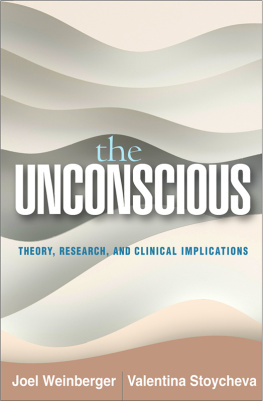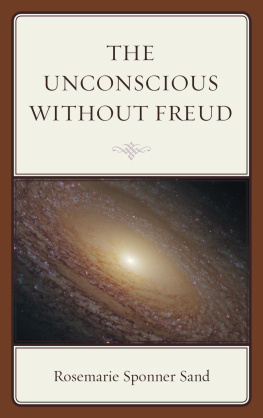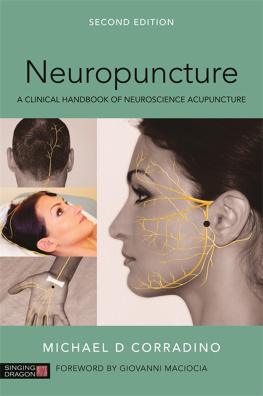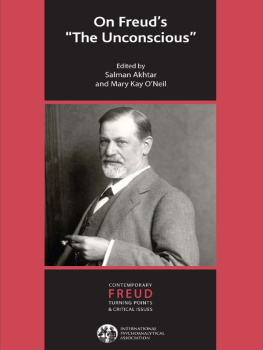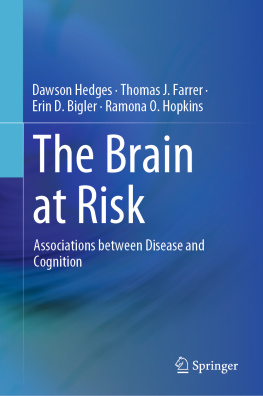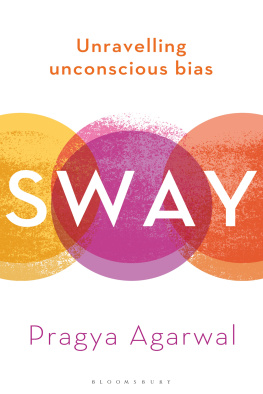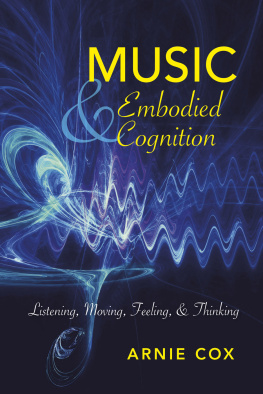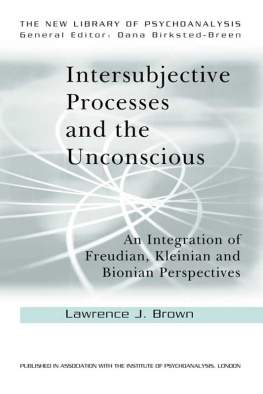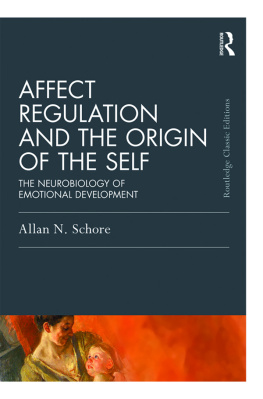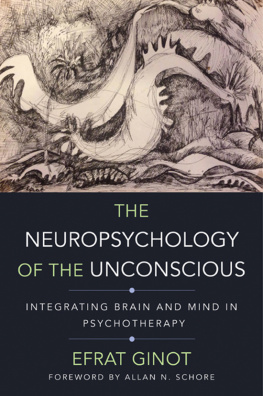Elliot Jurist, Series Editor
Books in this series aim to bridge the work of researchers and the work of clinicians. They reflect the current empirical findings and state of the art in psychoanalysis and psychodynamic treatment. They are written to be practical and relevant to clinicians.
Attachment and Psychoanalysis: Theory, Research, and Clinical Implications
Morris N. Eagle
Minding Emotions: Cultivating Mentalization in Psychotherapy
Elliot Jurist
The Unconscious: Theory, Research, and Clinical Implications
Joel Weinberger and Valentina Stoycheva
The UNCONSCIOUS
THEORY, RESEARCH, AND CLINICAL IMPLICATIONS
Joel Weinberger
Valentina Stoycheva
Series Editors Note by Elliot Jurist

THE GUILFORD PRESS
New York London
Epub Edition ISBN: 9781462541096
Copyright 2020 The Guilford Press
A Division of Guilford Publications, Inc.
370 Seventh Avenue, Suite 1200, New York, NY 10001
www.guilford.com
All rights reserved
No part of this book may be reproduced, translated, stored in a retrieval system, or transmitted, in any form or by any means, electronic, mechanical, photocopying, microfilming, recording, or otherwise, without written permission from the publisher.
Last digit is print number: 9 8 7 6 5 4 3 2
The authors have checked with sources believed to be reliable in their efforts to provide information that is complete and generally in accord with the standards of practice that are accepted at the time of publication. However, in view of the possibility of human error or changes in behavioral, mental health, or medical sciences, neither the authors, nor the editor and publisher, nor any other party who has been involved in the preparation or publication of this work warrants that the information contained herein is in every respect accurate or complete, and they are not responsible for any errors or omissions or the results obtained from the use of such information. Readers are encouraged to confirm the information contained in this book with other sources.
Library of Congress Cataloging-in-Publication Data
Names: Weinberger, Joel L., author. | Stoycheva, Valentina, author.
Title: The unconscious : theory, research, and clinical implications / Joel Weinberger, Valentina Stoycheva.
Description: New York : The Guilford Press, 2020. | Series: Psychoanalysis and psychological science | Includes bibliographical references and index.
Identifiers: LCCN 2019025679 | ISBN 9781462541058 (hardcover)
Subjects: LCSH: Subconsciousness. | Cognitive neuroscience.
Classification: LCC BF315 .W295 2019 | DDC 154.2dc23
LC record available at https://lccn.loc.gov/2019025679
Joel Weinberger, PhD, is Professor in the Derner School of Psychology at Adelphi University. He is a Fellow of the Association for Psychological Science and of the American Psychological Association. His research on unconscious processes has been recognized with the Ulf Kragh Award from the University of Lundh, Sweden. Author or coauthor of approximately 100 publications, Dr. Weinberger is a founder of Implicit Strategies, which consults for political campaigns, nonprofits, and businesses. His political and business commentaries have appeared in the national media. He is also a practicing clinical psychologist.
Valentina Stoycheva, PhD, is a staff psychologist at Northwell Health in Bay Shore, New York, where she works with military service members, veterans, and their families. She is also a cofounder and director of Stress and Trauma Evaluation and Psychological Services (STEPS), a group practice that focuses on the integrative treatment of trauma. Dr. Stoycheva has taught undergraduate- and graduate-level courses and has contributed to over a dozen publications and presentations in the fields of trauma, family dynamics, and the psychotherapy process. In 2018, she was named one of Adelphi Universitys 10 Under 10 outstanding young alumni.
A cross all domains of psychology, there is an appreciation of the importance of bringing research into closer proximity to practice. The language that is often and typically used is to seek to apply research to practice.
The Psychoanalysis and Psychological Science series embraces that aim and hopes to substantiate it. However, in order for research to be applied well to practice, it first must be interpreted and translated. Indeed, a strong motivation for this series is to demonstrate that research, which is informed by and responsive to theory, offers the most stimulating and optimal path for helping clinicians to be able to improve their work. I wish to affirm a positive connotation of the term philosophical precisely because it uses a less contested language that can foster communication between researchers and clinicians, at once providing a bridge to the past in psychology and a way forward.
It is a pleasure, therefore, to introduce into this series Weinberger and Stoychevas The Unconscious. This book reflects three decades of Joel Weinbergers accomplished work in the field. It draws on several branches of psychology and is attentive to arguments pro and con for whatever point of view is under consideration. For example, the authors introduce and discuss a wide range of contemporary theories and research about the unconscious from cognitive psychology and neuroscience. Part of their aim is to emphasize what has become displaced from psychoanalytic thinking about the unconscious. They argue as well that clinicians, psychodynamic as well as others, have failed to integrate this contemporary thinking and research in their work.
There is a genuine seeking for truth here, a balance that stands out against the clamor of assertions that we are decisively right and you are utterly wrong. The authors weigh arguments carefully and thoughtfully and are less concerned with defending a particular point of view than with suggesting fruitful lines of ongoing work and valuable insights for practitioners to take up and develop further. Yet, they do not shy away from clarifying where they believe the evidence pointssuch as defending the notion that the unconscious is normative and not the source of psychopathology, or that competing computational models, such as massive modularity, parallel distributed processing, and neural reuse, can be integrated. It is worth stressing how practical the authors conclusions are: I have had success in encouraging a patient to open up about bizarre associations, overcoming the fear of feeling too vulnerable, by encouraging an appreciation that this was simply how the mind works.
Given how ambitious the book is in terms of its breadth, readers from across the field are certain to learn new things, be they forgotten paths of research or the latest computational models. The book is especially valuable to clinicians who realize that in order to help their patients, they must become more knowledgeable about how the human mind functions and inspire patients in facing that there is much that they do not know about themselves. Bravely, Weinberger and Stoycheva are prepared to argue that recognizing unconscious processes as part of psychotherapy ensures, rather than diminishes, its future.
Elliot Jurist
T his is both an ambitious and a modest book. It arose out of our years-long efforts to understand unconscious processes empirically as well as our dedication to helping people whose quality of life is not what they wish it to be.
The goal of this book is to come to an understanding of unconscious processes. This goal is much simpler to state than to achieve, as the field of study of unconscious processes is not a unified one. Rather, it is often messy, controversial, and maze-like. Nonetheless, learning about it was tremendously rewarding. We hope the reader will feel similarly after reading our state-of-the-art review. But we are also clinicians and want to apply what we have learned about unconscious processes to psychotherapy. And we want the book to be accessible to researchers, clinicians, and curious educated laymen. To achieve these goals, we have adopted a comprehensive approach: we cover history, philosophy, research, clinical theory, and computational models of the mind. The breadth of knowledge in these areas helps us understand how we got to where we are, what we now know, and what kind of theory could encompass it all. We then take it one step further by applying it to psychotherapy and sketching a theory for that endeavor.
Next page
